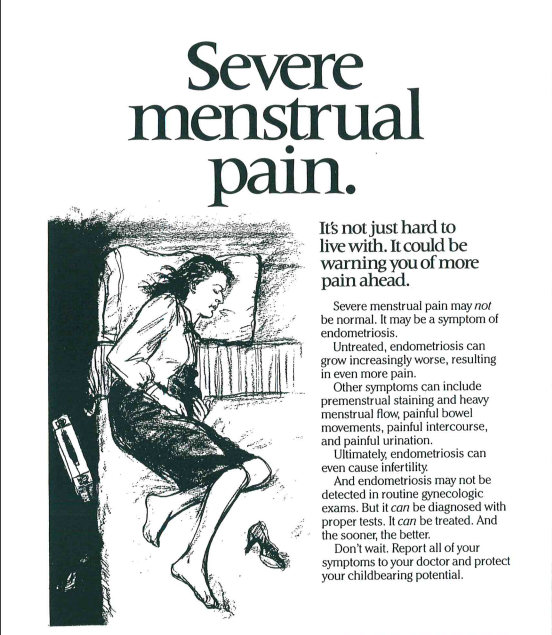Endometriosis affects millions of women, but the public perception of the disease hasn't always reflected its painful reality. After decades of research and advocacy efforts, however, attitudes toward endometriosis are shifting dramatically.
In honor of Endometriosis Awareness Month, we're taking a look at how increasing awareness has led to major strides in endometriosis diagnosis and treatment, improving patient and physician relationships along the way.
The History of Endometriosis Awareness

The 1987 awareness campaign. Image provided by the Endometriosis Association. © The Endometriosis Association.
Throughout most of the 20th century, clinical reports by largely male physicians tended to underestimate the pain and prevalence of endometriosis. Doctors and researchers suggested that women who chose to have children later in life were more likely to develop the condition, earning it the nickname "the career woman's disease." Despite diminishing evidence that pregnancy was a factor, that perception persisted well into the 1990s.
Mary Lou Ballweg, executive director and co-founder of the Endometriosis Association, has been instrumental in changing the medical and public perceptions of endometriosis. In 1980, Ballweg founded the association as well as an endometriosis research registry that now resides with the National Institutes of Health. By 1987, the Endometriosis Association had published its first book and launched a national awareness campaign, which brought over 2,000 patient calls a day to the organization's call center.
Fighting Misconceptions
Gathering patient experiences and objective data was critical in changing dismissive attitudes toward endometriosis pain and enabling female patients to speak up. Early in her career, Ballweg says, she encountered many doctors who thought women were merely exaggerating about their severe mentstrual pain or symptoms.
"The reality is most women and girls will wait until they can't stand it anymore before they'll go and talk to a physician," she says. Even some of the more outspoken women she's encountered have confessed they would be embarrassed to talk to their doctor about pain during sex — a common symptom of endometriosis.
Because many women — and some doctors — are conditioned to accept periods as a painful, many women struggle to talk about their symptoms and receive a timely diagnosis.
"There's still not enough change in terms of attitudes about menstruation and pain with sex, and [there's this] crazy idea that to be female is to suffer," Ballweg says.
Looking Toward the Future
Ballweg has seen major shifts in the recognition and treatment of endometriosis, but there's still work to be done.
The disease is still often framed as a reproductive issue, with infertility as its primary symptom. This focus on conception can undermine ongoing problems like dyspareunia and heavy menstrual bleeding. Non-fertility-related symptoms disproportionately affect teens and postmenopausal women, two groups that Ballweg notes tend to be underdiagnosed and undertreated.
Ballweg is hopeful about the role transvaginal ultrasound can play in helping women get diagnosed earlier.
"I'm excited about ultrasound because it can break through some barriers and provide an objective measurement," she says. Instead of relying on a patient to describe potentially embarrassing symptoms to multiple providers, gynecologists can perform imaging and make a diagnosis in-office. Companion tools like the Endometriosis Health Profile further help providers quantify symptoms and map the disease.
When performed by a trained sonographer, endometriosis ultrasound can pinpoint the location and severity of the disease and inform any necessary surgical intervention. Ultrasound is particularly helpful for diagnosing deep infiltrating endometriosis; standardized language and protocols informed by the International Deep Endometriosis Analysis group are now included with some ultrasound systems.
Endometriosis Awareness Month serves as a great reminder for healthcare professionals to continue to educate patients about this disease — because with more awareness, more women of all ages can feel comfortable bringing up their symptoms all year long.



